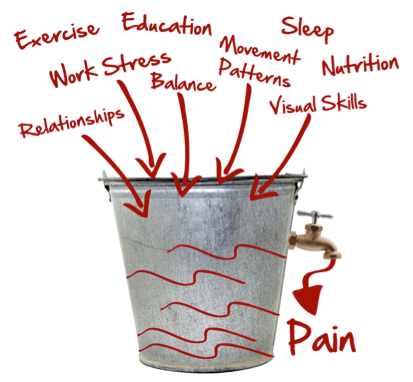I just can't cope!
You know that feeling you get when you can’t cope? That feeling of being overwhelmed where the smallest thing triggers an internal explosion that sooner or later you just have to let out – usually by shouting and screaming at someone!
You probably understand that your system has reached capacity and it can’t take any more, and you would be exactly right. But do you know how you reach capacity and what you can do to help?
Let me take you on a journey into your bathtub…
Incoming!
As you are reading this article, there are lots of inputs flowing into your brain and nervous system. The obvious one is sight – signals coming through your visual system. Unless you are lucky enough to be in a very quiet environment, you will also have some input from your hearing system. Your proprioceptive system is also sending signals, picking up things that you touch or are touching you. Did you also know that your vestibular (balance system) is firing signals up to 1 million times per second, and that’s just you sitting there doing nothing. As soon as you move, there are loads of integration signals going on as well.
If all that wasn’t enough, as you are moving your eyes reading the screen, you are firing all kinds of signals to do with the muscles that move your eye in all of it’s directions. And then there are all the internal signals… Your thoughts, internal dialogue, heartbeat, breathing… Even though some of these are automatic functions, signals are still being processed.
Basically, there are millions upon millions of input signals from various input systems all entering your nervous system all the time.
Threat Detection
At this point it’s important to point out that your nervous system and your brain are assessing all of these signals in terms of their threat potential. This is an ongoing process that is happening all of the time, and adjustments are made to facilitate the varying levels of threat the signals pose.
You can think of your capacity to handle threat as being your bathtub. Ordinarily, normal threats are all handled very well and you are able to keep your bath water well below the overflow. These normal threats aren’t really seen as threats because you can handle them easily and well within your capacity.
However, if the threat level rises too high, undesirable outputs will occur. The most common of these is pain, but can include all manner of things from muscle stiffness, emotional imbalance, reduced running performance and poor movement control.
When I learned about this concept during my Z-Health Practitioner training, it was presented to me as a Threat Bucket. It’s exactly the same as the bathtub analogy, but more round – and it has a tap rather than an overflow…
Anyway, here is the Threat Bucket showing some of the areas of your life that contribute to these threats:
Image credit: Z-Health Performance Solutions
Lowering Your Threat Level
The amazing thing about your nervous system though, is it’s capacity to be able to reduce your overall threat level by dealing with some of the things causing the threats. It has been shown that dealing with just one threat will make more room in your threat bucket and hopefully lowering your threat level below the overflow.
Some of the best ways of doing this is by addressing threats in the following three areas:
- Movement
- Visual
- Balance
There is another important point to touch on before I wrap up, and that’s why it matters for running.
Outside of the issue of pain being a major output, your running performance will suffer greatly if your threat level is too high.
Do you think your system is going to allow you to run fast for any length of time if you have poor vision and can’t see where the ground is or where things are around you?
How about if you have poor balance, given that running is predominantly a single leg activity?
What about if your hips don’t move well and you have difficulty generating power from them, instead relying on calves, hamstrings and quads too much. Do you think your system may introduce fatigue to stop you running fast or long distances in case you overuse your muscles?
So, the next time you feel like you are boiling over, not running well or getting tired when you think you shouldn’t, look at what is causing your threat level to rise. Then look at what you can do to help reduce your threat level. Can you move better? Can you do some vision work? How about working on your balance.
These are some of the things that I look at when I work with people, and this way of training is to look at things through a neural lens. It’s not a replacement for your current training, it’s an approach to make it far more effective.




Recent Comments